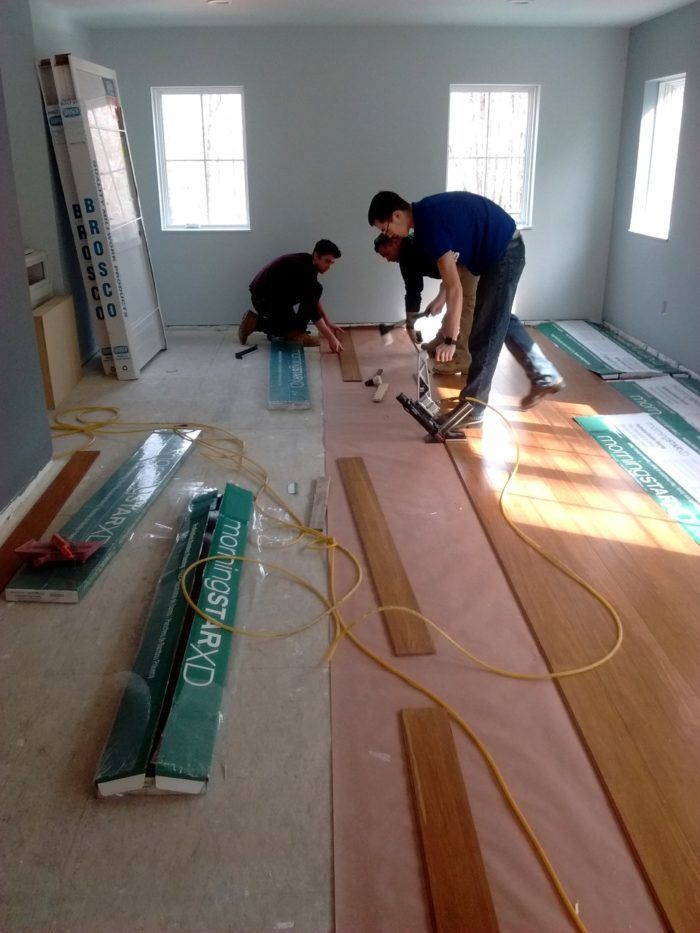Installing Bamboo Flooring
A crew of students installed 1350 square feet of strand-type bamboo flooring, giving the house a dramatic look


We loaded the flooring boxes into the house about a week before installation so the planks could acclimate to the humidity level in the house. Ideally we would have waited for two or more weeks, but time is a luxury we don’t always have building a new home. I brought my digital psychrometer to the warehouse where the flooring was stored for three weeks and got a reading of 24% — a fair bit lower than the 45% RH reading in the house. So, if anything, the flooring would likely expand rather than contract. We left a 1/2 in. expansion space around the perimeter of each room to allow for any expansion — that space will be concealed by the drywall (the drywall was left up about 3/4 in. off the subfloor) and the baseboard.

Ryan, Max, Nick, Damian, Addison, and Mr. Haynes worked on the flooring for nine 2-hour workdays over the course of three weeks, with down days due to snow days and holidays. We took extra care cleaning the floor. First we scraped off drywall compound drops, adhesive clumps, and any raised flakes of OSB; then we drove down any proud nails or screw heads before a thorough vacuuming.
The guys started on the second floor, where progress was slow due to the numerous doorways and direction changes using splines inserted into facing grooves.

The 1/2 in. thick bamboo is very hard, so we used 18 ga. ‘L’ cleat nailers rather than 16 ga. nailers or staplers typically used on hardwood flooring to reduce the chance of splitting the tongues off the boards. In tight spots and where the flooring nailers wouldn’t fit when closing in on walls, the crew used a palm nailer made for flooring nails that Mr. Haynes brought. Without the palm nailer, we would have had to pilot drill and drive hand nails.
Most of the first floor was wide open, so it only took two 2-hour days to install the kitchen/dining/living room. Worked slowed down significantly when it came to the entryway — not so much because of the cutting but because of the tight quarters where the palm nailer was used as much as the flooring nailers.

Bamboo cutting is hard even using freshly sharpened high quality carbide-tipped blades. It was noticeable how dense the strand bamboo, was compared to hardwoods like oak.
Professional installers may gag seeing us using red rosin paper instead of the requisite use of a vapor retarding underlayment like tar paper. I don’t believe one is necessary. The flooring is installed over moisture stabilized Advantech subfloor; moisture vapor levels are consistent throughout the house, and they should remain that way with the Zehnder ERV running continuously along with the Mitsubishi H/AC system. And I’ll be monitoring the relative humidity in the house for the next couple of years and will take measures if the level does exceed the target range of 35% to 50%.
The 5-1/4-in. prefinished tongue and groove planks have a dark rustic appearance that warms the rooms and will hide the inevitable scratches and dings that add character over time.

























































View Comments
Decent article. You think pros gag over red rosin? How about gagging over Lumber Liquidators products? A true pro wouldn't dare touch this brand of bamboo. Research before buying everyone.
Really on the Red Rosin? What did you save $.03/sq ft? If you didn't think you need a vapor retarder why use anything at all? I believe the NWFA calls out the none-use of rosin paper specifically because it wicks moisture. In other words, any moisture that does get through is just going to be held by the paper.
Also, agreed with Bobbydoggy on material choice. As well as the floor expanding could cause gapping, just as easily as it could from shrinking, by crushing the wood. very good.
I wouldn't trust a mechanical HVAC system to maintain humidity levels over the decades a floor is expected to last. I'd much rather trust a passive vapor barrier. Especially after the house changes hands a few times, HVAC maintenance isn't done or the systems aren't understood.